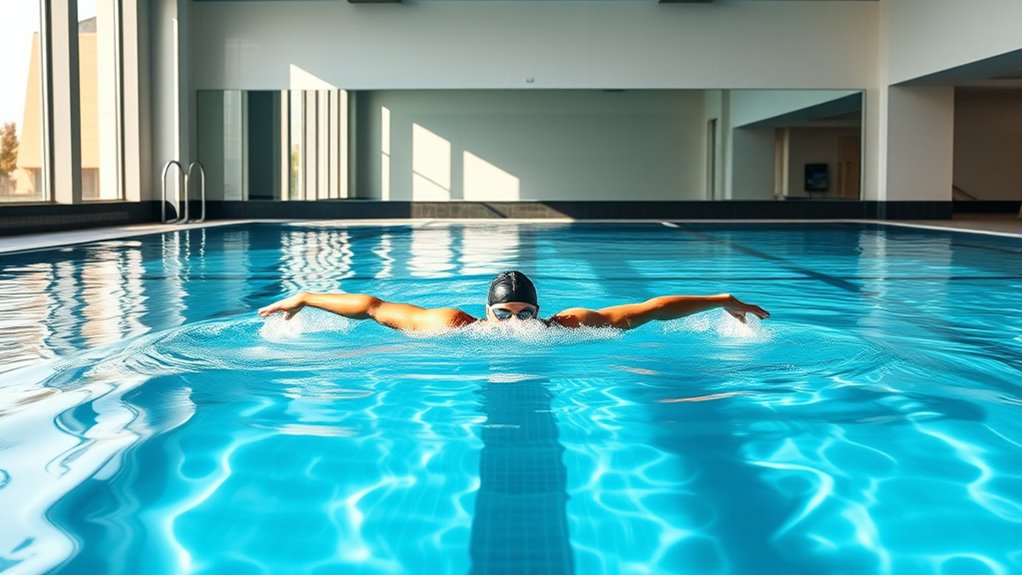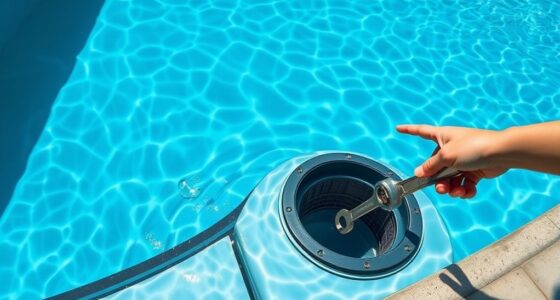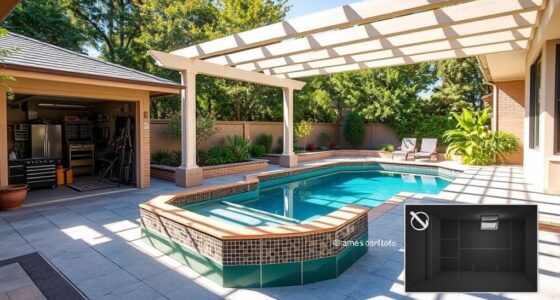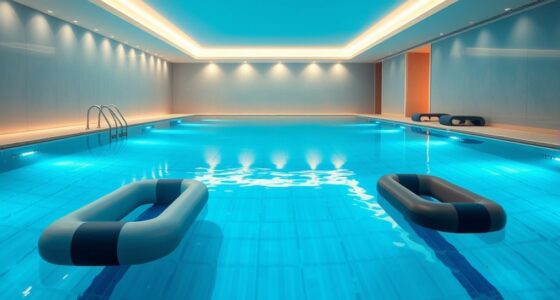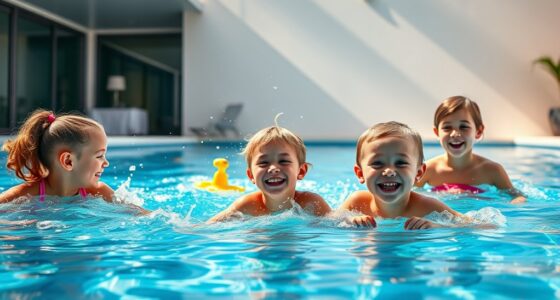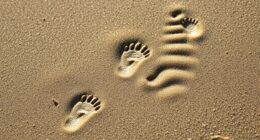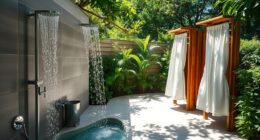Using mirrors in your endless pool is a game-changer for improving your swim form. They give you instant visual feedback, so you can make immediate adjustments and develop muscle memory faster than traditional coaching. Properly placed mirrors help you see your entire body and keep your technique on track. Keep an eye on your progress and avoid distractions, and you’ll notice better efficiency, power, and confidence. Stay tuned to learn how to maximize this powerful tool.
Key Takeaways
- Mirrors provide real-time visual feedback to correct swim technique instantly during practice.
- Proper placement ensures full-body visibility, helping you identify and adjust form errors effectively.
- Use anti-fog and water-resistant mirrors for clear, consistent reflections in your Endless Pool.
- Position mirrors perpendicular to your swim direction to minimize distortion and maximize feedback accuracy.
- Combine mirror feedback with internal sensations for comprehensive technique improvement and safer training.
Why Mirrors Are Essential for Improving Swim Technique

Mirrors are essential tools for swimmers because they allow you to see your form in real time, making it easier to identify and correct mistakes. When you can observe your body’s position and movements as you swim, you gain immediate feedback that’s vital for improvement. Instead of waiting to be evaluated by a coach, you can make quick adjustments to your stroke, breathing, and body alignment on the spot. This instant visual feedback helps you develop muscle memory faster and ensures your technique stays consistent. Over time, seeing your progress motivates you to refine your skills further. Using mirrors keeps you aware of your form, ultimately making your swim more efficient, powerful, and injury-free. Additionally, integrating projector technology can create a virtual mirror environment, providing an innovative way to monitor your swim form more effectively.
Selecting the Right Type of Mirror for Your Endless Pool
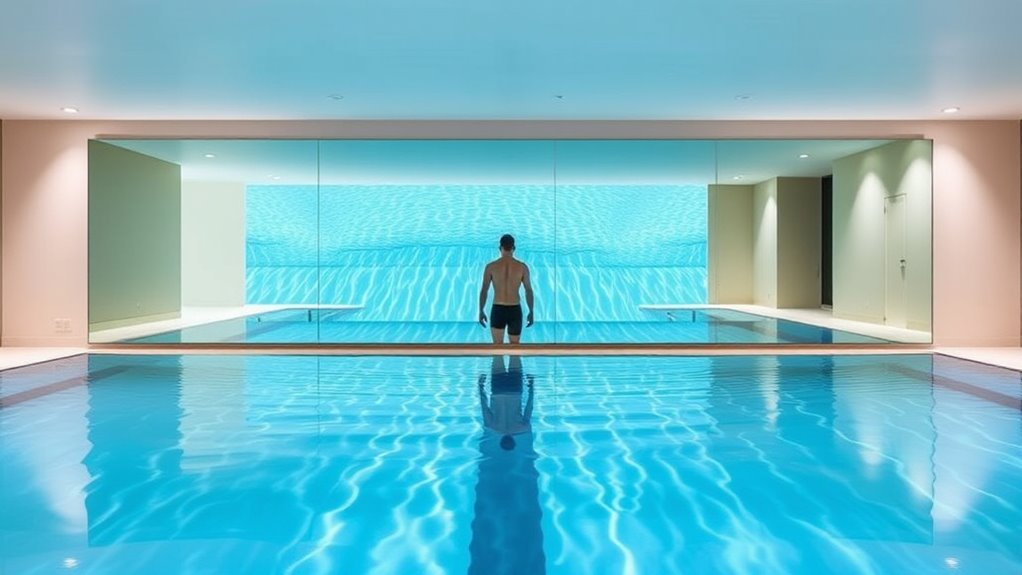
Choosing the right mirror for your endless pool is essential to guarantee you get clear, accurate feedback on your swim form. First, consider a tempered glass or acrylic mirror, as these materials are durable and resistant to water damage. Opt for a mirror with a smooth, flat surface to prevent distortions that could mislead your technique. Size matters—choose a mirror large enough to see your entire body from head to hips without needing to move excessively. If possible, select a mirror with an anti-fog coating or plan to use anti-fog solutions, ensuring clear visibility during your workout. Additionally, selecting a mirror with water-resistant features can help maintain its clarity and durability over time. Finally, make sure the mirror is securely mounted at the right height, so you can easily monitor your form without straining or adjusting constantly.
Strategically Positioning Mirrors for Optimal Feedback
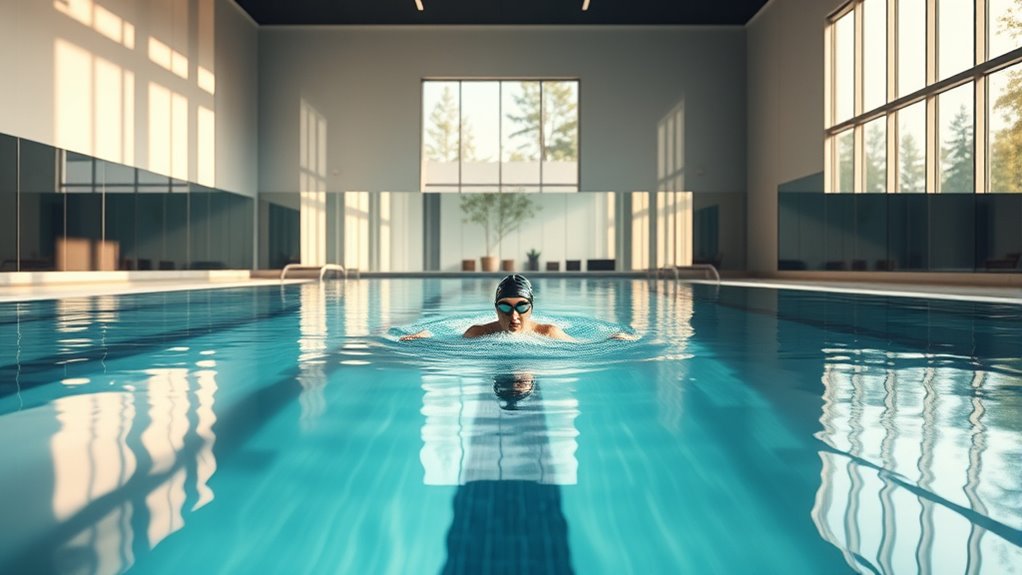
To get the most accurate feedback from your mirror, you need to think carefully about its placement in your pool area. Position it where you can see your entire body during your swim strokes without turning your head excessively. Ensure the mirror is at eye level or slightly above to minimize distortion. Consider angles that allow you to view key body parts—hips, shoulders, and head—simultaneously. Proper mirror placement can help you better assess your form and make immediate corrections.
- Place the mirror perpendicular to your swimming direction for a full view.
- Avoid reflections that cause glare or distort your image.
- Mount the mirror securely to prevent shifting during use.
- Test different positions to find where your form appears most natural and accurate.
Benefits of Using Mirrors Over Traditional Coaching Methods

While traditional coaching provides valuable guidance, using mirrors offers immediate visual feedback that can markedly enhance your swimming form. Mirrors allow you to see your body’s position, stroke, and alignment in real time, making it easier to correct errors instantly. Unlike waiting for a coach to observe and give feedback, mirrors give you continuous awareness of your technique. This instant correction speeds up learning and builds muscle memory more effectively. Additionally, regular use of mirrors can help you recognize fetal movements, which are essential for monitoring your pregnancy’s progress.
Tips for Incorporating Mirror Feedback Into Your Swim Routine
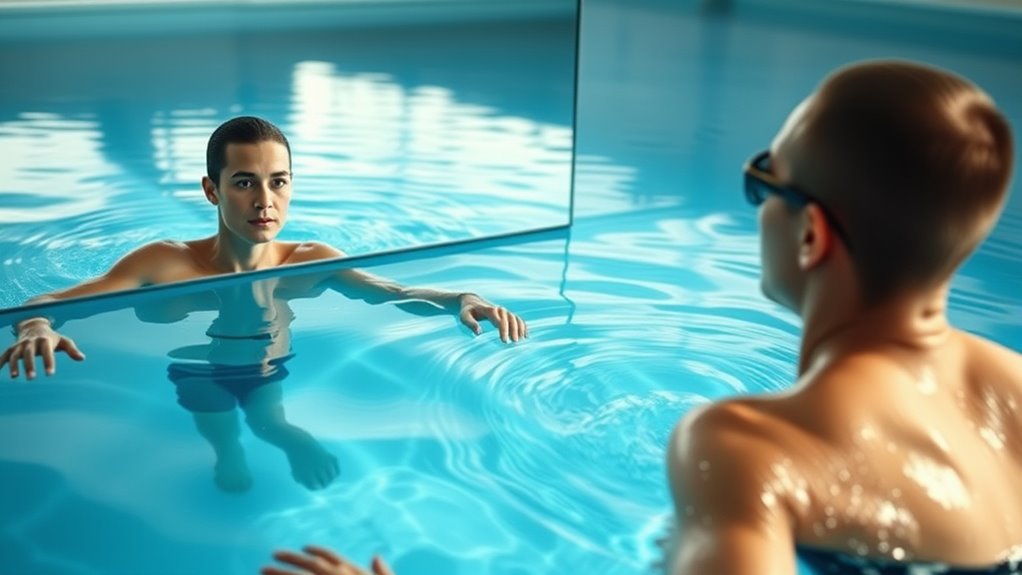
To get the most out of mirror feedback, start by placing your mirrors where you can easily see key parts of your stroke. Next, regularly review your technique and note areas for improvement. Finally, stick to a consistent practice schedule to build muscle memory and track your progress effectively. Using a paint sprayer to maintain consistent arm movement can help reinforce proper technique during your swim practice.
Proper Mirror Placement
Placing your mirrors correctly is essential for getting useful feedback during your swim practice. You want to position them so you can see your form clearly without straining or turning your head. Typically, mirrors should be placed at eye level directly in front of you or at a slight angle to capture your profile. Ensure they are steady and free of glare, which can distort your view. Adjust the height and angle as needed to optimize visibility of key movements like arm extension, body alignment, and head position. Consider these tips:
- Position mirrors at eye level for natural viewing angles
- Angle mirrors slightly downward or upward to see different perspectives
- Use multiple mirrors for exhaustive views of your stroke
- Keep mirrors clean and free of smudges for clear reflection
- Incorporate proper lighting to prevent shadows and enhance visibility during your swim routine
Analyzing Your Technique
Once your mirrors are properly positioned, focus on actively analyzing your technique during each swim. Watch for key elements like body alignment, head position, and arm movement. Pay attention to how smoothly your strokes flow and whether your body stays straight and streamlined. Use the mirror feedback to identify inconsistencies, such as over-rotation or uneven arm pulls. Take mental notes or even pause briefly after each lap to assess your form. Avoid rushing through your swim; instead, make small adjustments based on what you see. Consistent observation helps you develop muscle memory for correct technique. Incorporating mechanical elements, like gears and intricate Victorian-inspired details, into your visual feedback can enhance your focus and make the process more engaging. Over time, this visual feedback becomes an integral part of your training, sharpening your awareness and improving overall efficiency in the water.
Consistent Practice Strategies
Incorporating mirror feedback into your swim routine requires consistency and deliberate effort. To make the most of this tool, set a regular schedule, whether daily or several times a week. Focus on specific technique elements each session, such as body alignment or arm movement. Use the mirror to track your progress and adjust your form as needed. Keep a training journal to record improvements and challenges, reinforcing your commitment. Additionally, vary your drills to prevent plateaus and maintain engagement. Remember, feedback is most effective when integrated into a structured plan. With discipline and focused practice, you’ll develop better habits and see continuous improvements in your swim form.
Common Mistakes to Avoid When Using Mirrors During Practice

Using mirrors incorrectly can lead to poor form and confusion. Make sure your mirror angles are correct, so you see an accurate reflection, and avoid distractions in your view that can break focus. Don’t rely too much on mirrors; trust your feel and technique alongside visual feedback to improve effectively. Additionally, cultivating a relaxed state before practice can enhance your ability to notice subtle improvements and align your movements more effectively with your desired form.
Incorrect Mirror Angles
Incorrect mirror angles can considerably hinder your ability to improve your swimming form. If the mirrors aren’t positioned correctly, you may misjudge your posture, arm positioning, or head alignment. This can lead to developing bad habits or reinforcing improper techniques. To avoid this, ensure the mirrors are angled so you can see your entire body clearly without straining or turning excessively. Be cautious not to set the mirrors too high or too low, which skews your perspective. Also, avoid placing mirrors at shallow angles that distort your reflection, making it hard to assess your form accurately. Regularly check and adjust the mirrors to keep your view ideal. Proper mirror angles provide accurate feedback, essential for refining your technique efficiently. Additionally, consider the effectiveness and safety of your mirror setup to ensure consistent and reliable feedback during practice.
Distractions in View
When setting up your mirrors, it’s easy to become distracted by elements in your view, which can disrupt your focus and hinder your progress. Clutter, reflections from outside the pool, or movements behind the mirror can draw your attention away from your form. These distractions can cause you to lose concentration, leading to inconsistent technique or rushed strokes. To avoid this, position your mirrors where they only reflect your body and swimming area, minimizing extraneous sights. Keep the area around your pool tidy, and turn off bright lights or reflections that may catch your eye. Staying focused is key to using mirrors effectively, so eliminate anything that pulls your attention away from your form and your swim. Incorporating mindful decluttering strategies can help maintain a calm and distraction-free environment around your pool.
Over-reliance on Mirrors
While mirrors are valuable tools for improving your swimming form, over-relying on them can become a mistake. If you constantly check your reflection, you might focus too much on appearances rather than technique. This can lead to distractions and hinder your natural flow in the water. Additionally, overuse can cause you to become overly self-conscious, disrupting your rhythm and confidence. To avoid this, don’t depend solely on mirrors; instead, balance mirror checks with feel-based cues and coaching feedback. Be mindful of these pitfalls:
- Ignoring internal sensations of movement
- Becoming fixated on minor imperfections
- Developing dependency on visual confirmation
- Losing focus on overall body positioning
Frequently Asked Questions
Can Mirrors Help Improve My Breathing Techniques?
Yes, mirrors can help improve your breathing techniques. By watching yourself swim, you can observe your head position and body alignment, ensuring you’re not holding your breath or over-breathing. When you see your breathing rhythm, it’s easier to make adjustments for more efficient airflow. This visual feedback helps you develop consistent breathing patterns, making your swimming more comfortable and improving your overall technique.
Are There Specific Mirror Sizes Best Suited for Small Pools?
Yes, smaller pools benefit from smaller mirrors, typically around 12 to 24 inches. These sizes provide a clear view of your form without overwhelming limited space. You should position the mirror where you can see your head and shoulders easily, usually along the side wall or at the end of the pool. This setup helps you monitor your technique closely and make quick adjustments for better swimming efficiency.
How Often Should I Review Mirror Footage for Progress?
You should review your mirror footage weekly to truly see your progress and identify subtle improvements. But don’t just watch once—study your form in different angles and lighting, and compare sessions over time. This ongoing process keeps you motivated and aware of your development. Remember, consistency is key. The more frequently you analyze, the faster you’ll refine your technique and uncover that perfect swim stance you’ve been chasing.
Do Mirrors Work Equally Well for All Swimming Styles?
Mirrors can be effective for all swimming styles, but their usefulness varies based on your specific technique. They work particularly well for front crawl and backstroke, where visual feedback helps you refine arm movements and body alignment. For strokes like breaststroke or butterfly, mirrors still provide valuable insights, but combining them with coaching or video analysis might give you a more all-encompassing understanding. Adjust your mirror use based on your style and goals.
Can Mirrors Replace the Need for In-Person Coaching Entirely?
Mirrors can’t fully replace in-person coaching, just like a map can’t navigate every twist of a mountain trail. While they help you see your form and make adjustments, a coach provides personalized feedback, motivation, and expert insights that mirrors can’t replicate. Think of mirrors as a helpful guide, but a coach as the seasoned guide who knows the terrain and pushes you to reach your full potential.
Conclusion
By harnessing the reflective power of mirrors, you transform your endless pool into a personal coach that never sleeps. Each glance becomes a window into your progress, revealing hidden flaws and guiding you toward perfection. As you embrace this tool, your swim form sharpens like a blade, slicing through water with newfound grace. Keep your focus, trust the reflections, and watch your confidence and technique soar—turning your pool into a sanctuary of steady, unstoppable growth.
